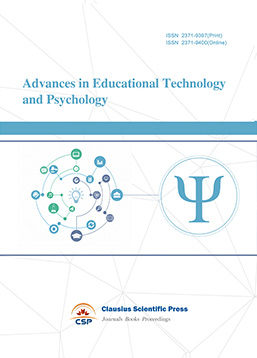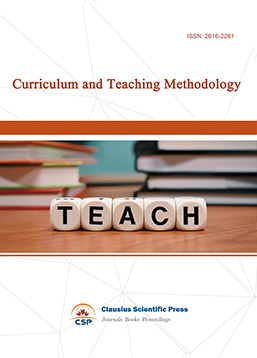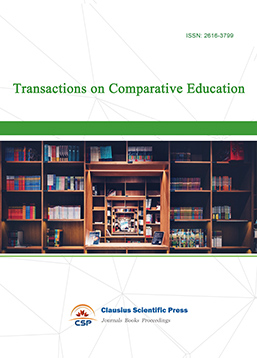Technology Acceptance Model as Explanatory Factor Influence the Use of Digital Technology by Ideological and Political Teachers in Universities
DOI: 10.23977/aduhe.2024.060719 | Downloads: 16 | Views: 902
Author(s)
Qian Jin 1,2, Seah Siok Peh 3
Affiliation(s)
1 Faculty of Education & Liberal Studies, City University Malaysia, Kuala Lumpur, Malaysia
2 Marxist College, Nanyang Medical College, Nanyang, Henan, China
3 Faculty of Human Development, Sultan Idris University of Education (UPSI), Tanjung Malim, Malaysia
Corresponding Author
Qian JinABSTRACT
The aim of this study is to provide educational administrators with information on the factors that influence the willingness of ideological and political education (IPE) teachers to use digital technology in their teaching. This can be explained by the Technical Acceptance Model (TAM). By examining the impact of perceived ease of use, perceived usefulness, and attitude on the intention to use digital technology in teaching, this study elucidates the key factors influencing the willingness of ideological and political education teachers to use digital technology in teaching, and addresses the intention behavior gap in technology adoption. By identifying these factors, educational institutions can better enhance their understanding of the relationship between technology availability, practicality, and adoption decisions, prepare teachers to utilize digital technology, and thus improve the quality and effectiveness of IPE.
KEYWORDS
Technology Acceptance model, Digital Technology, Ideological and Political TeachersCITE THIS PAPER
Qian Jin, Seah Siok Peh, Technology Acceptance Model as Explanatory Factor Influence the Use of Digital Technology by Ideological and Political Teachers in Universities. Adult and Higher Education (2024) Vol. 6: 131-140. DOI: http://dx.doi.org/10.23977/aduhe.2024.060719.
REFERENCES
[1] Zhao, H., & Li, Y. (2020). The Evolving Role of IPE Educators in the Digital Age. Journal of Educational Technology, 31(2), 145-158.
[2] Huang, R., Chen, G., & Chou, C. (2021). Augmented Reality in Education: An Overview and Meta-Analysis. Educational Technology Research and Development, 69(6), 2611-2634.
[3] Wang, H. (2020). Accelerating Education Reform in the Information Age. Journal of Educational Development, 38(3), 45-52.
[4] Zheng, L. (2011). The Rise of Digital Technologies and Their Impact on Business Growth. Journal of Digital Innovation, 5(3), 45-58.
[5] Zhang, X., Li, Y., & Wang, Z. (2023). Enhancing Ideological and Political Education with Digital Technologies. Journal of Educational Technology and Society, 26(1), 34-49.
[6] Means, B., Toyama, Y., Murphy, R., Bakia, M., & Jones, K. (2024). The Effectiveness of Online and Blended Learning: A Meta-Analysis of the Empirical Literature. Teachers College Record, 115(3), 1-47.
[7] Fang, W. (2014). Perspectives on Ideological and Political Education in Contemporary China. China Education Journal, 23(1), 98-112.
[8] Deng, Jingyan. (2021). The Role of Ideological and Political Education in Shaping Moral and Political Understanding. Journal of Ideological Education, 45(2), 134-145.
[9] Gao, Q., & Li, H. (2018). Utilizing Digital Analytics in Ideological and Political Education. Computers & Education, 127, 12-23.
[10] Zhang, Y. (2021). Student Behavior and Digital Learning: A Comprehensive Study. Journal of Educational Technology Research and Development, 69(5), 1213-1234.
[11] Wang, J., Zhang, H., & Liu, X. (2019). The Impact of Digital Learning Tools on Student Performance. Computers & Education, 135, 104-116.
[12] Steffen, W., Rockström, J., Richardson, K., Lenton, T. M., Folke, C., Liverman, D., ... & Schellnhuber, H. J. (2018). Trajectories of the Earth System in the Anthropocene. Proceedings of the National Academy of Sciences, 115(33), 8252-8259.
[13] Marmot, M., & Bell, R. (2019). Social determinants and non-communicable diseases: time for integrated action. BMJ, 364, l251.
[14] Bedregal-Alpaca, N., Cornejo-Aparicio, V., Tupacyupanqui, D., & Flores-Silva, S. (2019). Evaluación de la percepción estudiantil en relación al uso de la plataforma Moodle desde la perspectiva del TAM. Ingeniare. Revista chilena de ingeniería, 27, 707-718
[15] Legramante, D., Azevedo, A., & Azevedo, J. M. (2023). Integration of the technology acceptance model and the information systems success model in the analysis of Moodle's satisfaction and continuity of use. The International Journal of Information and Learning Technology
[16] Coelhoso, P. (2019). Factors Influencing Mobile Marketing Acceptance in Higher Education Students in the United Arab Emirates. (PhD degree doctoral thesis), Fernando Pessoa University
[17] Mustafa, A. (2021). Researchers often use TAM theory to identify factors that influence users' intentions to adopt a technology. Journal of Technology Adoption Studies, 15(3), 45-62
[18] Davis, F. (1989). Perceived Usefulness, Perceived Ease of Use, and User Acceptance of Information Technology. MIS Quarterly, 13, 319
[19] Natalia, T. (2004). Analisa Penerimaan Penerapan Teknik Audit Berbantuan Komputer (Tabk) Dengan Menggunakan Technology Acceptance Model (Tam) Pada Badan Pemeriksa Keuangan (Bpk) RI. Jurnal Akuntansi dan Keuangan Universitas Kristen Petra, 6(1)
[20] Fasima, M. H., Ahmad, M. B., Shaari, Z. H., & Jannat, T. (2021). Integration of TAM, TPB, and TSR in understanding library user behavioral utilization intention of physical vs. E-book format. The Journal of Academic Librarianship, 47(5), Article 102399
[21] Al-Hattami, H. M. (2023). Understanding perceptions of academics toward technology acceptance in accounting education. Heliyon, 9(1)
[22] Sánchez-Prieto, J. C., Olmos-Migueláñez, S., & García-Peñalvo, F. J. (2017). MLearning and pre-service teachers: An assessment of the behavioral intention using an expanded TAM model. Computers in Human Behavior, 72, 644-654
[23] Yadegaridehkordi, E., Nilashi, M., Shuib, L., & Alzahrani, A. I. (2019). Exploring the decision-making process in adopting online collaborative learning tools in higher education: The role of perceived usefulness. Journal of Educational Technology & Society, 22(4), 24-35
[24] Alshurafat, H., Abu Shanab, E., & Alshurafat, S. (2021). Factors influencing the use of online learning systems by accounting students in Jordanian public universities: An integration of SCT, TRA, and TAM. Journal of Educational Research and Practice, 11(3), 150-162.
[25] Hamid, A. A., Razak, F. Z. A., Bakar, A. A., & Abdullah, W. S. W. (2016). The effects of perceived usefulness and perceived ease of use on continuance intention to use e-government. Procedia Economics and Finance, 35(2016), 644-649
[26] Mou, J., Shin, D. H., & Cohen, J. (2017). Understanding trust and perceived usefulness in the consumer acceptance of an e-service: a longitudinal investigation. Behaviour and Information Technology, 36(2), 125-139
[27] Yoon, H. Y. (2016). User Acceptance of Mobile Library Applications in Academic Libraries: An Application of the Technology Acceptance Model. Journal of Academic Librarianship, 42(6), 687-693
[28] Abdullah, F., & Ward, R. (2016). Developing a General Extended Technology Acceptance Model for E-Learning (GETAMEL) by analysing commonly used external factors. Computers in Human Behavior, 56, 238-256
[29] Briz-Ponce, L., & García-Peñalvo, F. J. (2015). An Empirical Assessment of a Technology Acceptance Model for Apps in Medical Education. Journal of Medical Systems, 39(11)
[30] Calisir, F., Altin Gumussoy, C., Bayraktaroglu, A. E., & Karaali, D. (2014). Predicting the intention to use a web-based learning system: Perceived content quality, anxiety, perceived system quality, image, and the technology acceptance model. Human Factors and Ergonomics In Manufacturing, 24(5), 515-531
[31] Mailizar, M., Burg, D., & Maulina, S. (2021). Examining university students’ behavioural intention to use e-learning during the COVID-19 pandemic: An extended TAM model. Education and Information Technologies, 26, Article 10557.
[32] Wong, G. K. W. (2015). Understanding technology acceptance in pre-service teachers of primary mathematics in Hong Kong China. Australasian Journal of Educational Technology, 31(6), 713-735
[33] Creswell, J. W. (2013). Research design: Qualitative, quantitative, and mixed methods approaches: Sage publications
[34] Saunders, M., Lewis, P., & Thornhill, A. (2016). Research methods for business students (Seven edition ed.). Harlow: Pearson Education Limited.
[35] Hair, J. F., Jr., Black, W. C., Babin, B. J., Anderson, R. E., & Tatham, R. L. (2010). SEM: An introduction. Multivariate Data Analysis: A Global Perspective, 629-686
[36] Krejcie, R. V., & Morgan, D. W. (1970). Determining sample size for research activities. Educational and Psychological Measurement, 30(3), 607-610.
[37] Bartlett, J. E., Kotrlik, J. W., & Higgins, C. C. (2001). Organizational research: Determining appropriate sample size in survey research. Information Technology, Learning, and Performance Journal, 19(1), 43-50.
[38] Dillman, D. A., Smyth, J. D., & Christian, L. M. (2014). Internet, phone, mail, and mixed-mode surveys: The tailored design method. Wiley.
[39] Groves, R. M., & Peytcheva, E. (2008). The impact of nonresponse rates on nonresponse bias: A meta-analysis. Public Opinion Quarterly, 72(2), 167-189.
[40] Reynolds, N., & Diamantopoulos, A. (1998). The effect of pretesting on error detection: An experimental investigation. Journal of the Market Research Society, 40(3), 1-11.
[41] Zikmund, W. G., Babin, B. J., Carr, J. C., & Griffin, M. (2013). Business research methods: Cengage Learning Custom Publishing
[42] Stover, R. E., & Others. (1996). Guidelines for Conducting Pilot Studies. Journal of Business Research, 35(1), 25-40.
[43] Hertzog, M. A. (2008). Considerations in determining sample size for pilot studies. Research in Nursing & Health, 31(2), 180-191.
[44] Nunnally, J. C., & Bernstein, I. H. (1994). Validity. Psychometric Theory. New York: McGraw-Hill.
| Downloads: | 22176 |
|---|---|
| Visits: | 1244490 |

 Download as PDF
Download as PDF



